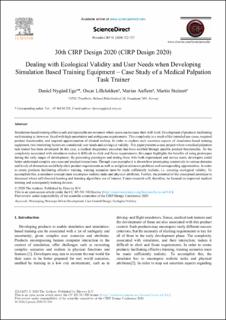| dc.contributor.author | Ege, Daniel Nygård | |
| dc.contributor.author | Lilleløkken, Oscar | |
| dc.contributor.author | Auflem, Marius | |
| dc.contributor.author | Steinert, Ralf Martin | |
| dc.date.accessioned | 2021-02-01T15:35:39Z | |
| dc.date.available | 2021-02-01T15:35:39Z | |
| dc.date.created | 2020-08-25T10:48:41Z | |
| dc.date.issued | 2020 | |
| dc.identifier.citation | Procedia CIRP. 2020, 91 722-727. | en_US |
| dc.identifier.issn | 2212-8271 | |
| dc.identifier.uri | https://hdl.handle.net/11250/2725667 | |
| dc.description.abstract | Simulation-based training offers a safe and repeatable environment where users can increase their skill level. Development of products facilitating such training is, however, faced with high uncertainty and ambiguous requirements. This complexity is a result of the intended use-cases, required product functionality and required approximation of clinical realism. In order to explore such uncertain aspects of simulation-based training equipment, two interesting factors are considered; user needs and ecological validity. This paper presents a case project where a medical palpation task trainer has been developed. In this case, a medical diagnostics procedure has been enabled through specific product functionality. As the complexity associated with simulators makes it difficult to elicit and fixate requirements, this paper highlights the benefits of using prototypes during the early stages of development. By presenting prototypes and testing these with both experienced and novice users, developers could better understand complex use cases and product interactions. Through case examples it is shown how prototyping extensively in various domains and levels of abstraction could help elicit product requirements as well as enlighten unknown problems and corresponding opportunities. In order to create products facilitating effective training, training scenarios must be made sufficiently realistic, i.e. ensuring ecological validity. To accomplish this, a simulator concept must encompass realistic tasks and physical attributes. Further, the potential of the conceptual prototype is discussed where self-directed learning and learning algorithms are of interest. Future research will, therefore, be focused on improved medical training and consequently training devices. | en_US |
| dc.language.iso | eng | en_US |
| dc.publisher | Elsevier | en_US |
| dc.rights | Attribution-NonCommercial-NoDerivatives 4.0 Internasjonal | * |
| dc.rights.uri | http://creativecommons.org/licenses/by-nc-nd/4.0/deed.no | * |
| dc.title | Dealing with Ecological Validity and User Needs when Developing Simulation Based Training Equipment – Case Study of a Medical Palpation Task Trainer | en_US |
| dc.type | Peer reviewed | en_US |
| dc.type | Journal article | en_US |
| dc.description.version | publishedVersion | en_US |
| dc.source.pagenumber | 722-727 | en_US |
| dc.source.volume | 91 | en_US |
| dc.source.journal | Procedia CIRP | en_US |
| dc.identifier.doi | 10.1016/j.procir.2020.03.116 | |
| dc.identifier.cristin | 1824972 | |
| dc.relation.project | Norges forskningsråd: 290404 | en_US |
| dc.description.localcode | © 2020 The Authors. Published by Elsevier B.V. This is an open access article under the CC BY-NC-ND license (http://creativecommons.org/licenses/by-nc-nd/4.0/) | en_US |
| cristin.ispublished | true | |
| cristin.fulltext | original | |
| cristin.qualitycode | 1 | |

